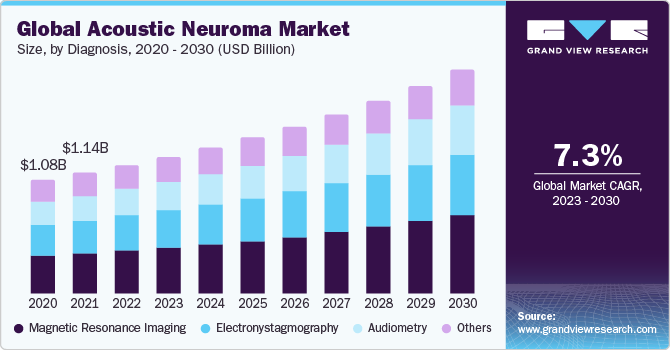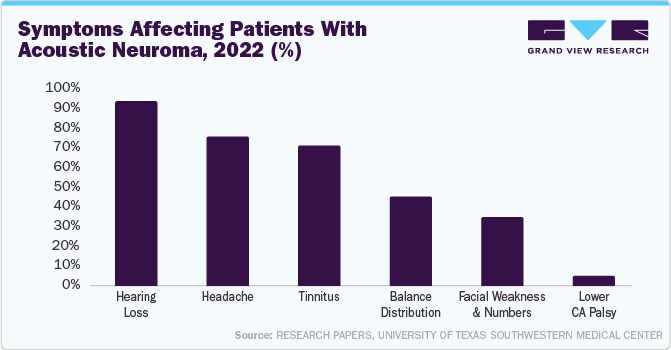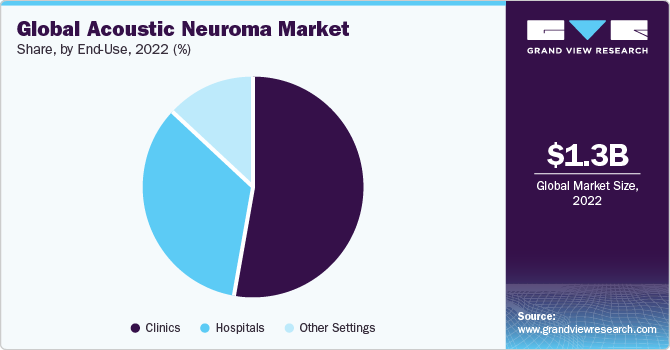- Home
- »
- Medical Devices
- »
-
Acoustic Neuroma Market Size, Share & Trends Report, 2030GVR Report cover
![Acoustic Neuroma Market Size, Share & Trends Report]()
Acoustic Neuroma Market Size, Share & Trends Analysis Report, By Diagnosis (Audiometry, Electronystagmography, Magnetic Resonance Imaging), By Treatment Type, By End-Use, By Region, And Segment Forecasts, 2023 - 2030
- Report ID: GVR-4-68040-172-4
- Number of Report Pages: 100
- Format: PDF, Horizon Databook
- Historical Range: 2018 - 2021
- Forecast Period: 2023 - 2030
- Industry: Healthcare
Acoustic Neuroma Market Size & Trends
The global acoustic neuroma market size was valued at USD 1.3 billion in 2022 and is expected to grow at a compound annual growth rate (CAGR) of 7.30% from 2023 to 2030. The acoustic neuroma market is primarily influenced by the increasing occurrences of inherited genetic mutations that lead to uncontrolled nerve cell growth and tumor formation. Furthermore, the growing prevalence of high-dose radiation exposure to the head or neck potentially causes DNA damage in tissues. Additionally, the expanding use of effective medications like non-steroidal anti-inflammatory drugs (NSAIDs), corticosteroids, and anticonvulsants to manage symptoms and improve the quality of life for individuals with this condition further stimulates market growth.

Moreover, the widespread adoption of non-invasive stereotactic radiosurgery techniques capable of targeting and reducing small- to medium-sized cancerous cells in patients not candidates for open surgeries is a significant growth driver. The increasing popularity of microsurgery, which focuses on preserving facial nerve and hearing function while removing the tumor, is anticipated to propel the acoustic neuroma market in the forecast period.
An acoustic neuroma is a benign tumor that forms on the vestibular nerve, responsible for transmitting balance and auditory signals from the inner ear to the brain. Typically, these tumors grow slowly and are predominantly located on one side, although rare instances involve both. The primary symptom of this condition is gradual hearing loss or a sensation of fullness in the affected ear. Other associated signs include continuous ringing or buzzing in the ear, vertigo, dizziness, facial numbness or weakness, recurring headaches, and balance issues.
The diagnosis of acoustic neuroma primarily relies on a thorough assessment of clinical characteristics, medical history, and a physical examination. A vestibular function test may be administered to evaluate the patient's balance and equilibrium and assess the tumor's impact on the vestibular nerve. Additionally, a contrast magnetic resonance imaging (MRI) scan produces detailed brain and internal auditory canal images, ruling out any other underlying health conditions.
Diagnosis Insights
Based on the diagnosis, the acoustic neuroma market is segmented into audiometry, electronystagmography, magnetic resonance imaging, and others. The magnetic resonance imaging segment held the largest market share in 2022. Acoustic neuroma is typically diagnosed using magnetic resonance imaging (MRI) with a contrast dye. This imaging procedure is capable of detecting tumors as small as 1 to 2 millimeters in diameter. In cases where MRI is not available or feasible, an audiometry test is conducted by an audiologist. During this assessment, sounds are delivered to one ear at a time, encompassing a range of tones. The patient indicates each time they hear a sound, and the tones are presented at gradually lower levels to determine the point at which the patient can barely hear them.

Treatment Type Insights
Based on treatment type, the market is segmented into drugs and radiation therapy. The radiation therapy segment dominated the market in 2022. A form of radiation therapy called stereotactic radiosurgery can be employed to treat an acoustic neuroma, especially when the tumor is small, measuring less than 2.5 centimeters in diameter. Radiation therapy may also be considered for older individuals or those who cannot undergo surgery due to health-related reasons.
Stereotactic radiosurgery, as exemplified by techniques like Gamma Knife and CyberKnife, utilizes numerous minute gamma rays to deliver a highly precise dose of radiation directly to the tumor. This approach provides a means of treatment without causing harm to the surrounding tissue or necessitating an incision. The primary objectives of stereotactic radiosurgery include halting tumor growth, preserving the functionality of the facial nerve, and potentially conserving the patient's hearing.
End-Use Insights
Based on end use, the acoustic neuroma market is segmented into hospitals, clinics, and others. The clinics segment is expected to grow at the fastest CAGR over the forecast period. Clinics focusing on neurological and ear-related disorders have specialized healthcare practitioners with extensive experience treating acoustic neuromas. These clinics often include neurotologists, audiologists, and surgeons who are well-versed in the specific challenges posed by acoustic neuromas. Their expertise in these conditions can lead to more targeted and effective treatments. Individualized treatment plans are essential for the diagnosis and treatment of acoustic neuromas. Clinics provide the same personalized and patient-centric approach to the patients.

Regional Insights
North America dominated the market in 2022. The U.S. has a well-established and advanced healthcare infrastructure. This includes state-of-the-art medical facilities, equipment, and a highly skilled workforce. The U.S. has a significant prevalence of this condition. As the population ages, there's a growing number of individuals at risk for acoustic neuromas, which contributes to the market's size.
Asia Pacific is anticipated to grow fastest over the forecast period. As acoustic neuromas are more common in older individuals, the increasing elderly population is a significant market driver. Moreover, the rising healthcare awareness and the importance of early diagnosis and treatment in Asia-Pacific. As people become more conscious of their health, they are more likely to seek medical attention for symptoms related to acoustic neuromas.
Key Companies & Market Share Insights
Key players operating in the market are F. Hoffmann-La Roche AG, Amgen, Roche, Natus Medical Incorporated, Elekta, Natus Medical Incorporated, Pfizer Inc., CIVCO MEDICAL SOLUTIONS, Novartis AG, MAICO Diagnostics GmbH, Siemens Healthcare GmbH, and Interacoustics A/S, and. Market players are always striving to explore new market opportunities through the development of new products, M&A deals, and other strategic partnerships. In June 2023, there was an update on an upcoming clinical trial, sponsored by the Medical College of Wisconsin in the U.S., which was set to commence, involving 36 participants, with the aim of assessing the effectiveness of both microsurgical resection and stereotactic radiosurgery for the treatment of vestibular schwannoma.
Share this report with your colleague or friend.
![gvr icn]()
NEED A CUSTOM REPORT?
We can customize every report - free of charge - including purchasing stand-alone sections or country-level reports, as well as offer affordable discounts for start-ups & universities. Contact us now
![Certified Icon]()
We are GDPR and CCPA compliant! Your transaction & personal information is safe and secure. For more details, please read our privacy policy.
We are committed towards customer satisfaction, and quality service.
"The quality of research they have done for us has been excellent."





